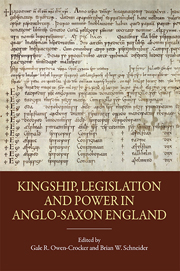Book contents
- Frontmatter
- Contents
- List of Illustrations
- List of Tables
- Contributors
- Preface
- Abbreviations
- Introduction
- PART I
- PART II
- 2 Anglo-Saxon Royal Archives: Their Nature, Extent, Survival and Loss
- 3 Naming and Royal Authority in Anglo-Saxon Law
- 4 Witnessing Kingship: Royal Power and the Legal Subject in the Old English Laws
- 5 The Burial of Kings in Anglo-Saxon England
- 6 Ine 70.1 and Royal Provision in Anglo-Saxon Wessex
- 7 Being Everywhere at Once: Delegation and Royal Authority in Late Anglo-Saxon England
- Index of persons and places
6 - Ine 70.1 and Royal Provision in Anglo-Saxon Wessex
from PART II
Published online by Cambridge University Press: 05 December 2013
- Frontmatter
- Contents
- List of Illustrations
- List of Tables
- Contributors
- Preface
- Abbreviations
- Introduction
- PART I
- PART II
- 2 Anglo-Saxon Royal Archives: Their Nature, Extent, Survival and Loss
- 3 Naming and Royal Authority in Anglo-Saxon Law
- 4 Witnessing Kingship: Royal Power and the Legal Subject in the Old English Laws
- 5 The Burial of Kings in Anglo-Saxon England
- 6 Ine 70.1 and Royal Provision in Anglo-Saxon Wessex
- 7 Being Everywhere at Once: Delegation and Royal Authority in Late Anglo-Saxon England
- Index of persons and places
Summary
Since the publication of John Mitchell Kemble's Saxons in England in 1848, the concept of the itinerant ruler has been long acknowledged, if not always fully appreciated, as a major feature of Anglo-Saxon kingship. A practice which was hardly unique amongst their European contemporaries and arguably emergent from notions of what was practicable in the post-Roman West for the victualling of the king and his followers, in Anglo-Saxon England this took the shape of feorm, a term which referred to the render of goods and entertainment. Proximity and the ability of the king to be seen at known times was an important corollary – if not the indeed the function – of this practice.
I have argued elsewhere that the landholdings recorded in Domesday Book as providing the ‘farm of one night’ are a significant feature of royal provision in the West Saxon landscape. Like others. I am of the opinion that there is evidence in Domesday Book for continuity of provision in kind for a royal court. However, it is not the intention of this paper to revisit the details of this system but rather to explore the wider implications of the royal usage of landholdings in Wessex, considering the development of the king's feorm on a broader canvas.
- Type
- Chapter
- Information
- Kingship, Legislation and Power in Anglo-Saxon England , pp. 259 - 274Publisher: Boydell & BrewerPrint publication year: 2013



